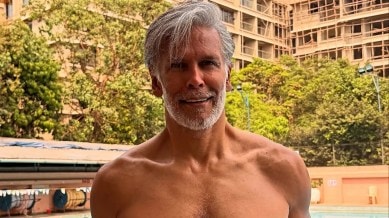📣 For more lifestyle news, click here to join our WhatsApp Channel and also follow us on Instagram
Milind Soman recalls losing 6-7 kilos with intermittent fasting at 59: ‘I had more energy’
Milind’s experience is encouraging, but it should be viewed as one example rather than a one-size-fits-all strategy

Milind Soman, 60, spoke about his experience with intermittent fasting at 59, saying he felt amazing. “I experimented with it. Last November, I started with 16:8 intermittent fasting just to see what it would feel like. I thought it felt fantastic. It really felt amazing,” the December 16 said.
Revealing the results, he continued: “In fact, I lost 6-7 kilos, which I didn’t know I had to lose. I always thought I was perfect. Everyone also told me I am perfect. But I lost 6 kilos and I had more energy. I felt more alert. It was such a positive experience. I only stopped doing it when we went into this half-Ironman marathon because you have to eat whatever you get all the time. It’s an endurance event. I haven’t restarted it. But it was an amazing experience. Right now, I am not on it because we are doing a full Iron Man coming up,” added Milind, who was accompanied by his wife, Ankita Konwar.
Speaking with FPJ Showbiz, Milind also added that, “organically,” he stuck to about 14 hours of fasting by sleeping at 9 pm every day till the age of 23, when he was actively representing India in swimming and eating a balanced diet at home.
Taking a cue from the fitness buff’s candid confession, let’s understand how the body can respond well to structured habits even later in life.
“From a nutrition point of view, early and consistent fasting windows can support better insulin sensitivity, improve digestive rest and help the body tap into fat stores, especially when paired with good hydration, balanced meals and regular physical activity. His results also reflect the importance of maintaining adequate protein and recovery so that weight loss does not lead to muscle loss,” said consultant dietitian Garima Goyal.
At the same time, intermittent fasting is not suitable for everyone. Goyal said that people with diabetes, thyroid issues, acidity, active lifestyles, hormonal concerns, or a history of disordered eating may find fasting difficult or counterproductive.
The success of this approach depends entirely on individual health status, activity level, and the quality of food eaten during eating windows.
“Milind’s experience is encouraging, but it should be viewed as one example rather than a one-size-fits-all strategy,” said Milind.
DISCLAIMER: This article is based on information from the public domain and/or the experts we spoke to. Always consult your health practitioner before starting any routine.
📣 For more lifestyle news, click here to join our WhatsApp Channel and also follow us on Instagram